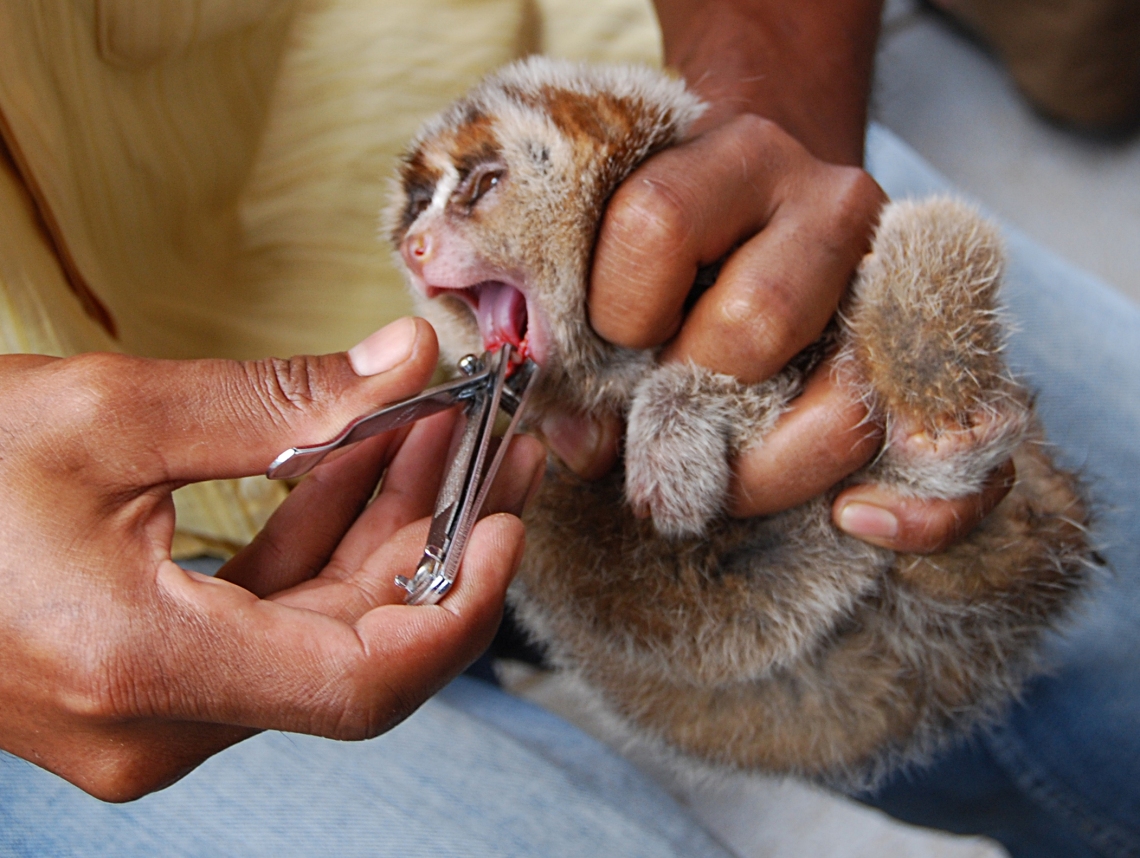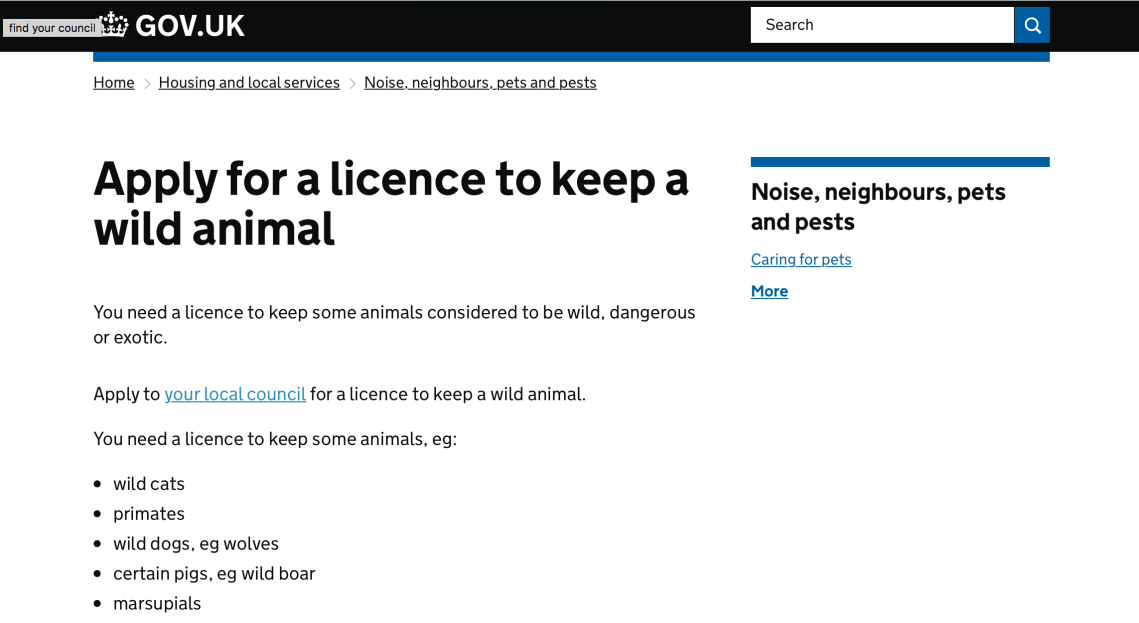There are many threats to the conservation of primates with the most significant being habitat loss – an increasing threat to all biodiversity (Hanski, 2011). The dangerous effects of habitat destruction through deforestation, habitat fragmentation through urbanisation and habitat degradation through climate change have been widely reported to be the main threats to all species. However, the wildlife trade, a quickly growing market, is developing into the greatest and most direct threat to many exotic animals, including several species of primates. Primates are traded for many industries either for their physical materials such as meat or ingredients in medicine, or for their services in the entertainment industry and as pets (Nijman et al., 2011). Here, we cover examples of several primate species hunted specifically for the exotic pet trade, the detrimental consequences and suggestions for conservation.
From forests to markets
Animals that are commonly domesticated as pets such as dogs and cats have been bred by humankind over generations, adapting to anthropogenic habitats and lifestyles. With increasing globalisation and greater interest in the curios, exotic animals have been taken out of their natural habitats and exported into households for those that desire them for their unique appearances or companionship. The act of placing a wild animal into a home brings health risks for both the human and non-human primate. Furthermore, although some intermediary stages may not, most of the trade in these wild animals involve illegal acquirement and transfer, due to high demand and lack of enforceable legislation in the countries they are poached from.
Shepherd (2010) surveyed bird markets in North Sumatra, Indonesia, from 1997 to 2008 where primates were being sold openly to the public and observed ten primate species, of which six were protected by the national legislation, for sale. The three highest-traded primates were the Greater slow loris (Nycticebus coucang), Long-tailed macaque (Macaca fascicularis) and Pig-tailed macaque (Macaca nemestrina) where nearly 2000 were observed during the decade-long survey despite the Nycticenus and M.nemestrina categorised as ‘Vulnerable’ in the IUCN Red List. The lack of enforced legislation and lack of awareness of the conservation status of these primates by the locals who sell them and the public who buy them are central to the persistence of the market. Of these species, the lorises (Nycticebus) are notably under increasing threat lately from the pet trade in Indonesia due to the spike in demand following the highly viewed videos on social media platform, YouTube, where a loris is appeared to be tickled by a human (Nekaris et al., 2013). The public perception of the lorises as cute animals and as ‘living toys’ are the driving forces for local hunters to specialise in these species. The main demographic are Western tourists who are willing to pay up to $100 for an individual in pity or for desire, unaware of the illegality of their practice (Sanchez, 2008).
Lorises are subject to rapid population decline from habitat fragmentation caused by deforestation and road constructions (CITES, 2006) which has led to limited dispersal and death from using electric power lines in substitute for vines and lianas that they use for locomotion (Nekaris et al., 2013). Not only does the pet trade diminishes the wild population that are left in the patchy habitats, poor treatment at the markets and during transit means that the mortality rate of captured lorises are very high, reaching 90% (Sanchez, 2008). Like other exotic animals in the industry, they are malnourished and kept in cages or tied to a piece of string whilst a common practice with lorises is manually clipping their teeth with a pair of clippers without the use of anaesthetics. Therefore, it is not only the poor physical treatment that results in these high mortality rates but also the emotional stress laid upon these creatures from entrapment and live surgery that contributes to low survivability. High mortality rates are similarly observed in other primate species that are traded illegally around the world. Death before the completion of transactions ultimately encourages intensified poaching to compensate for the lack of successful deals, further causing damage to wild primate populations.

The ecological consequences of forcibly removing members of wild populations for the pet trade must also come into consideration. Aside from directly reducing populations, the majority of trade-targeted individuals tend to be juveniles as they are smaller, weaker and easier to capture as well as being considered “cuter”. Therefore, although the reproductive population persists, as they get older, they will have significantly fewer emerging adults and a highly reduced adult group that are able to reproduce for the next generation. The aftereffects of poaching for the pet trade is less obvious in the present however it will destroy wild primate populations in the near future. Further considerations involve predicting the impact on the ecosystem the primates are a part of. Many primates are frugivores such as the capuchins, and they are also a highly poached primate group especially in the Americas (Ceballos-Mago, González and Chivers, 2010). As frugivores, they are essential seed dispersers for tropical forest trees therefore removal of these creatures will lead to cascading effects on the ecosystem. A study of forest fragments in Kibale National Park showed lower seedling density and species richness in fragments with reduced primate seed dispersers and highlighted the importance of frugivorous primates in the biodiversity of fruit trees and the subsequent ecological niches they provide for other organisms (Chapman and Onderdonk, 1998). Thus, the exotic pet trade is detrimental not only to the primates directly involved but the ecosystems they were poached from.
Tackling the problem
With lax enforcement of regulations protecting primate species from poaching and trade, it may seem that focusing on these governments for a solution is the obvious option. However, with exotic primates originating from less developed countries that have governments and markets based on corruption, it is almost impossible to force such governments to enforce legislations that will hinder one of their biggest economic markets. Such actions will affect every level of the pet trade poachers to sellers and transporters that will amount to significant losses in the country’s already weak economy. Therefore, the most effective target for change should not be the suppliers but the consumers – the wealthier individuals from developed countries such as the USA and UK.
It is still legal to keep wild animals, including primates, as pets in the UK by acquiring a license (Gov.uk, 2016) and many states in the USA also permit domestication of wild primates too. This clearly shows how regulations in consumer countries must be forced to illegalise these activities with other wildlife trades such as ivory having success in the last 30 years. However, such legislations come to prominence from public awareness and education regarding the effects of wildlife trades.

With the latest interest in wild primate domestication spreading through online viral videos, education on these unusual behaviours exhibited by these primates is vital. The change in public perception to the notable slow loris video where the loris has its arms raised whilst it is being ‘tickled’ is an example of the effect media can have both for and against the pet trade and the importance of education. After initially reaching millions of view on YouTube, there was a phenomenal rise in the number of people uploading subsequent videos of their pet lorises and the public outcry from many to have one for themselves. However, following programmes by the BBC Natural History Unit amongst others, that informed the audience of the outstretched arm being a sign of stress and the dangerously venomous nature of these creatures along with disturbing footages of the illegal trade of Javan slow lorises in Indonesia, the public turned (Nekaris and Campbell, 2012). The following weeks and months consisted of removal of these videos from social media platforms amidst claims of animal abuse and most comments underneath these videos were voices of disgust and an outcry for the banning of this trade. Such use of the media should be utilised to highlight the ethical problems involved in the exotic pet trade.
The exotic pet trade is an ever-increasing problem and it is the responsibilities of both the government and the public to enforce the banning of this trade through legislations, stopping purchase and increased awareness and education. Those primate species that are rescued must also be returned to its appropriate habitats once ready as species from vast-ranging places can be poached and collected into just a few markets (Nekaris and Jaffe, 2007).
References
Ceballos-Mago, N., González, C. and Chivers, D. (2010). Impact of the pet trade on the Margarita capuchin monkey Cebus apella margaritae. Endangered Species Research, 12(1), pp.57-68.
Chapman, C. and Onderdonk, D. (1998). Forests without primates: Primate/plant codependency. American Journal of Primatology, 45(1), pp.127-141.
CITES, (2006). Consideration of Proposals for Amendment of Appendices I and II. Notification To The Parties. Geneva.
Gov.uk. (2016). Apply for a licence to keep a wild animal – GOV.UK. [online] Available at: https://www.gov.uk/licence-wild-animal [Accessed 19 Dec. 2016].
Hanski, I. (2011). Habitat Loss, the Dynamics of Biodiversity, and a Perspective on Conservation. AMBIO, 40(3), pp.248-255.
Nekaris, B., Campbell, N., Coggins, T., Rode, E. and Nijman, V. (2013). Tickled to Death: Analysing Public Perceptions of ‘Cute’ Videos of Threatened Species (Slow Lorises – Nycticebus spp.) on Web 2.0 Sites. PLoS ONE, 8(7), p.e69215.
Nekaris, K. and Campbell, N. (2012). Media attention promotes conservation of threatened Asian slow lorises. Oryx, 46(02), pp.169-170.
Nekaris, K. and Jaffe, S. (2007). Unexpected diversity of slow lorises (Nycticebus spp.) within the Javan pet trade: implications for slow loris taxonomy. Contributions to Zoology, 76(3), pp.187-196.
Nekaris, K., Shekelle, M., Rode, E., Nijman, V. and Shekelle, (2013). Nycticebus javanicus. The IUCN Red List of Threatened Species.
Nijman, V., Nekaris, K., Donati, G., Bruford, M. and Fa, J. (2011). Primate conservation: measuring and mitigating trade in primates. Endangered Species Research, 13(2), pp.159-161.
Sanchez, K. (2008). Indonesia’s Slow Lorises Suffer in Trade. International Primate Protection League, 35(2), p.10.
Shepherd, C. (2010). Illegal primate trade in Indonesia exemplified by surveys carried out over a decade in North Sumatra. Endangered Species Research, 11(3), pp.201-205.

